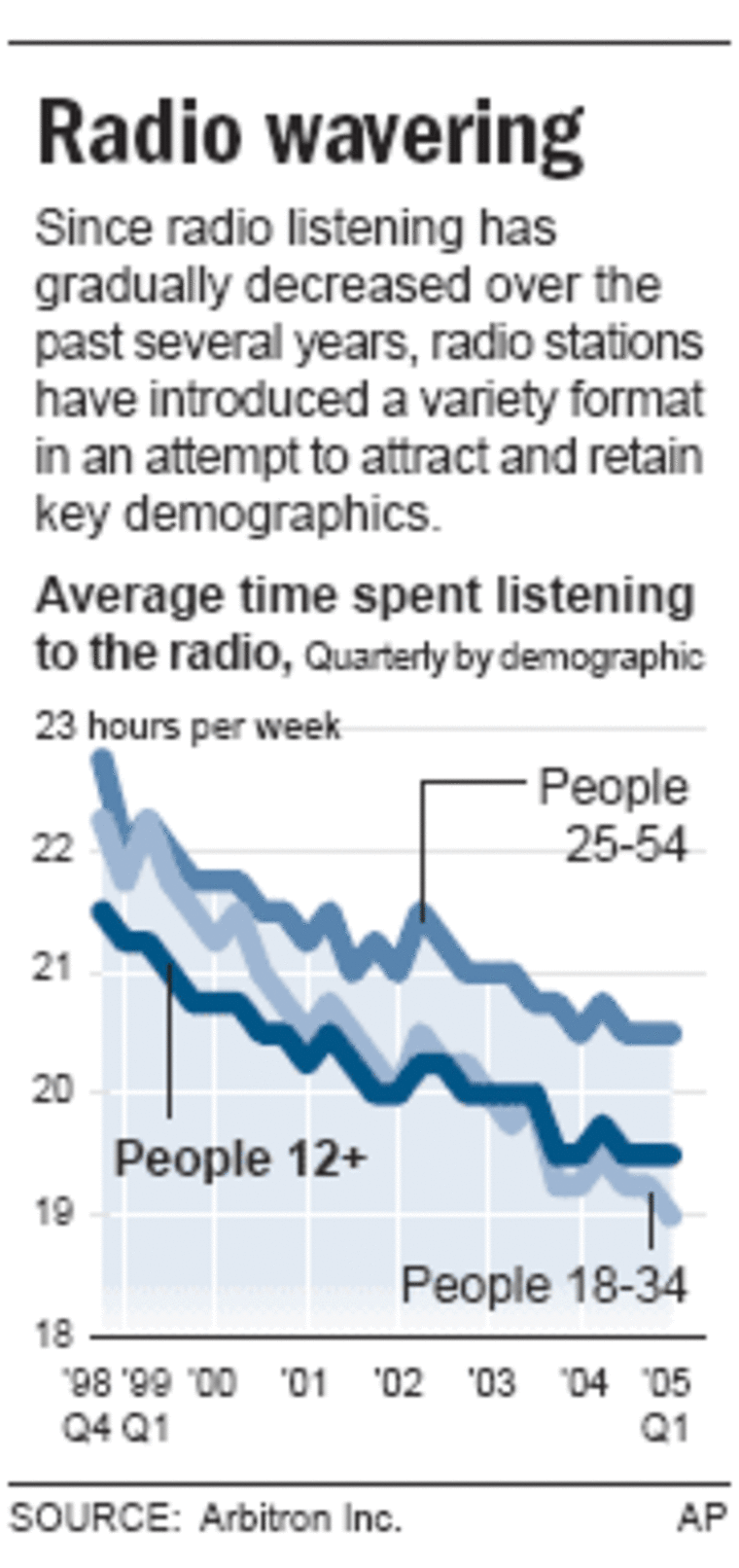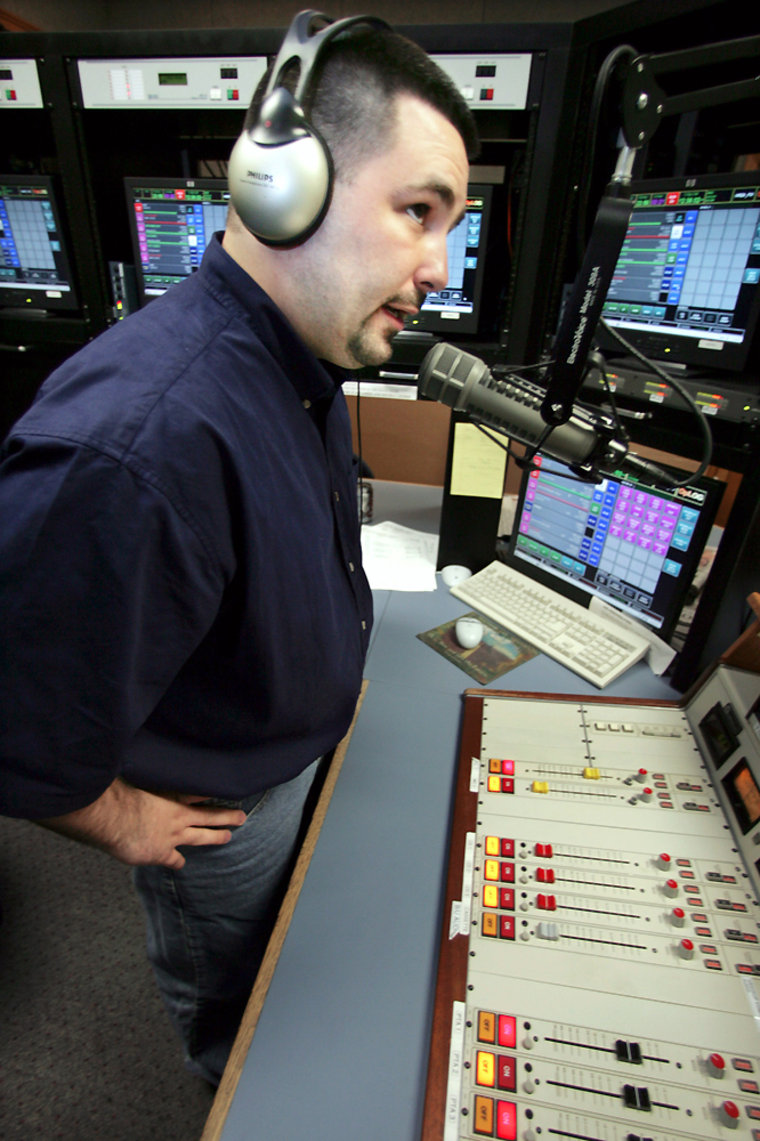The posters hanging on the walls of the broadcasting booth at Nine FM are as eclectic as the music the radio station plays — Pink Floyd and Aerosmith sharing space with the Marx Brothers, the Rat Pack and the Beatles.
“We play anything” is the station's mantra, and to prove it, program director and afternoon personality Matt DuBiel's afternoon mix moves from Boz Scaggs to Prince to Cheap Trick.
With names like Jack and Bob (or Fickle and Nine), radio stations promising an anything-goes mix of pop and rock hits are springing up across the country. The variety format is seen, in part, as a way to appeal to listeners used to loading their own iPods with music from different genres — or to keep those thinking about switching to satellite.

But more than that, it's a mea culpa to music lovers who started tuning out as their favorite stations shrunk their playlists in the 1990s, leaving the same old songs to play hour after hour.
The stations tell listeners “we play what we want” or “we play anything.” But they're really carefully crafted to keep advertisers happy, observers say. Song choices target a lucrative but musically hard-to-define demographic, 25- to 54-year-olds, who want to hear new music but not rap and bubblegum pop, and who declare themselves too young to listen to the oldies.
“This is oldies wrapped up in new wrapping paper and a new bow,” said Tom Taylor, editor of Inside Radio, a trade publication owned by Clear Channel Communications Inc.
The variety format began in Canada three years ago and migrated into U.S. markets a little over a year ago. While the original Canadian formats, called Jack and Bob, differ somewhat — Bob introduces more new music and Jack sticks to older hits — they and other U.S. variety stations share some basic themes.
They're heavy on the '80s and '90s. They play mainly hits, but hits that haven't been heard on the radio for a while. They aren't afraid of “train wreck” segues, running, for example, a classic rock hit into an '80s pop confection.
For Harvey Wells, vice president and group station manager for Newsweb Radio Group, Nine FM's owner, inspiration struck sitting at a college bar with his 21-year-old daughter. After hearing hard-rock AC/DC followed by pop from Huey Lewis and the News, then followed by country singer Kenny Chesney, he asked her if she thought the mix was strange.
“And she said, ‘Why strange?’”Wells said. “‘It's just good music.’”
People always liked a variety of music, but as radio stations consolidated under corporate owners, playlists got shorter, said Bob Sinclair, president of Sinclair Communications, which launched the first U.S. Bob station in Norfolk, Va., 14 months ago.
“The big suits worried about their Wall Street stock price ... and there were these so-called experts telling station owners (that) to be successful you have to narrow your focus to a particular segment of music,” he said.
Listeners tuned out. Americans 12 and older now spend about 19.5 hours a week listening to the radio, down from 21.5 hours a week in 1998, according to Arbitron's annual American Radio Listening Trends report. Radio advertising, which boomed in the 1990s, grew only 2 percent last year, according to the Radio Advertising Bureau.
Bob Perry, a veteran radio programmer, started the variety format on the Internet radio station JACK.FM in 2000 and later licensed the name for terrestrial stations in Canada and the U.S.
One of the converted is 32-year-old Stacy Jill Jacobs, who recently started listening to Jack FM in Los Angeles. Jacobs has an iPod loaded with her favorites, but likes the station's eclectic nature and element of surprise.

“It's completely random, and the choices that they make are hilarious,” Jacobs said.
Not everyone is a believer, though. Michael Saffran, who worked for years as a DJ, has listened to Fickle in Rochester, N.Y., and doesn't expect it to stick around for long. The scan button on his radio dial does the same job, he said.
“If you're going to listen to some wide range of music, it might as well be the stuff you pick yourself,” Saffran said.
The Canadian Bobs and Jacks have had staying power, giving variety radio backers a weapon against naysayers who call the format another fad akin to all-'80s or jammin' oldies, both of which came and went quickly.
Sinclair's variety stations have done well in the Arbitron ratings, and only one — in Honolulu — has fizzled. Bob Sinclair notes Bob FM in Austin, Texas, has rated No. 1 in its market's 25-54 demographic.
Variety stations are rarely the leaders in any particular market, but they have proven a reliable way for station owners to boost their market shares, said Sean Ross, vice president of music and programming at Edison Media Research, a consulting firm.
In Chicago, Nine FM, playing on three frequencies, hasn't made a dent in the ratings yet. But since its entry into the market, the city's alternative station has expanded its playlist and declared itself “on shuffle,” and a hot adult contemporary station now says it plays “today's new music ... and whatever we want.”
The stations will have to figure out a way to keep listeners once the novelty wears off, said Ross. That may include introducing new music into the mix, or finding interesting personalities — many now eschew DJs or give them little air time.
“The big mantra for Jack and Bob and all these formats is that they're a mile wide and an inch deep, and that will have to give eventually,” Ross said. “That said, I'm not one of those people who believe this is a fad format.”
